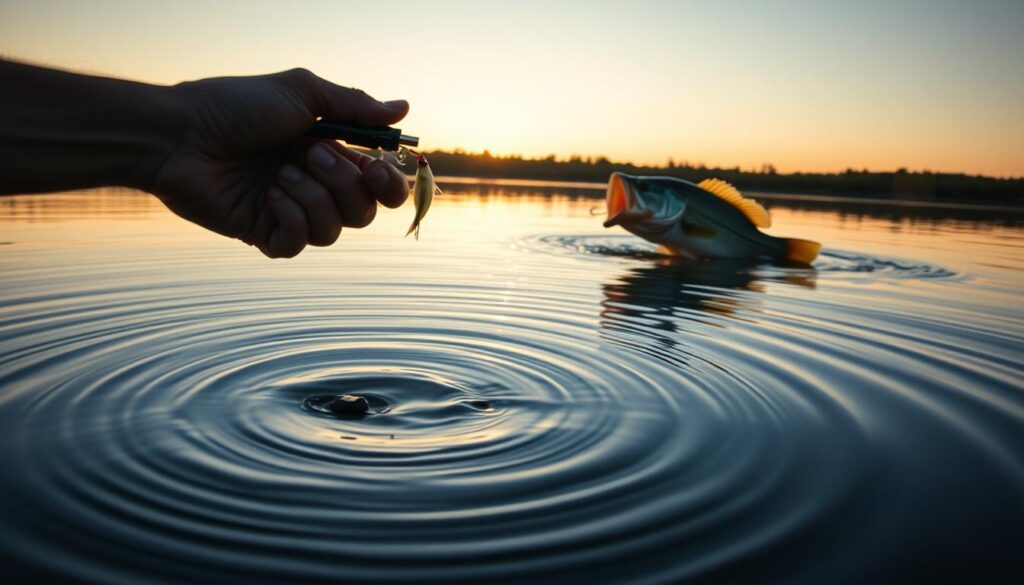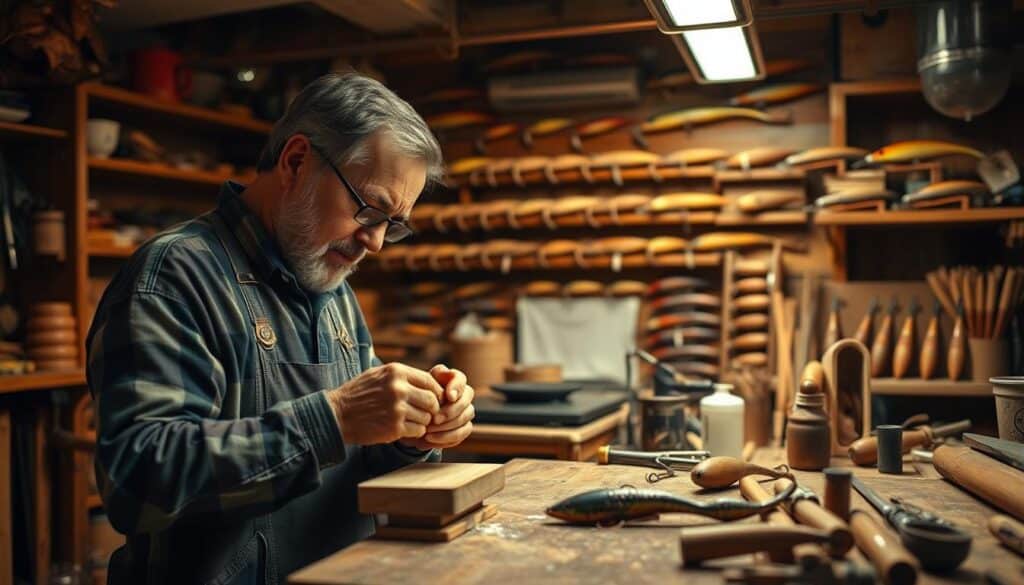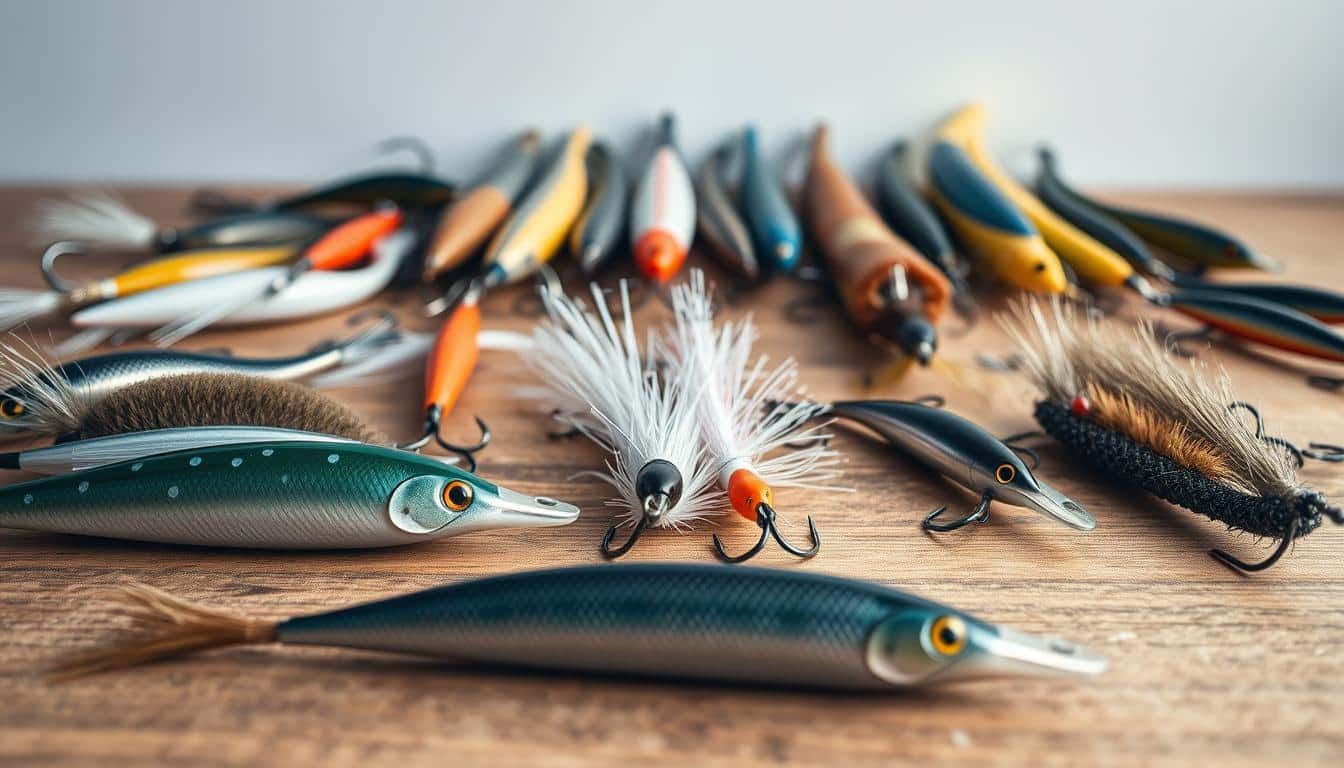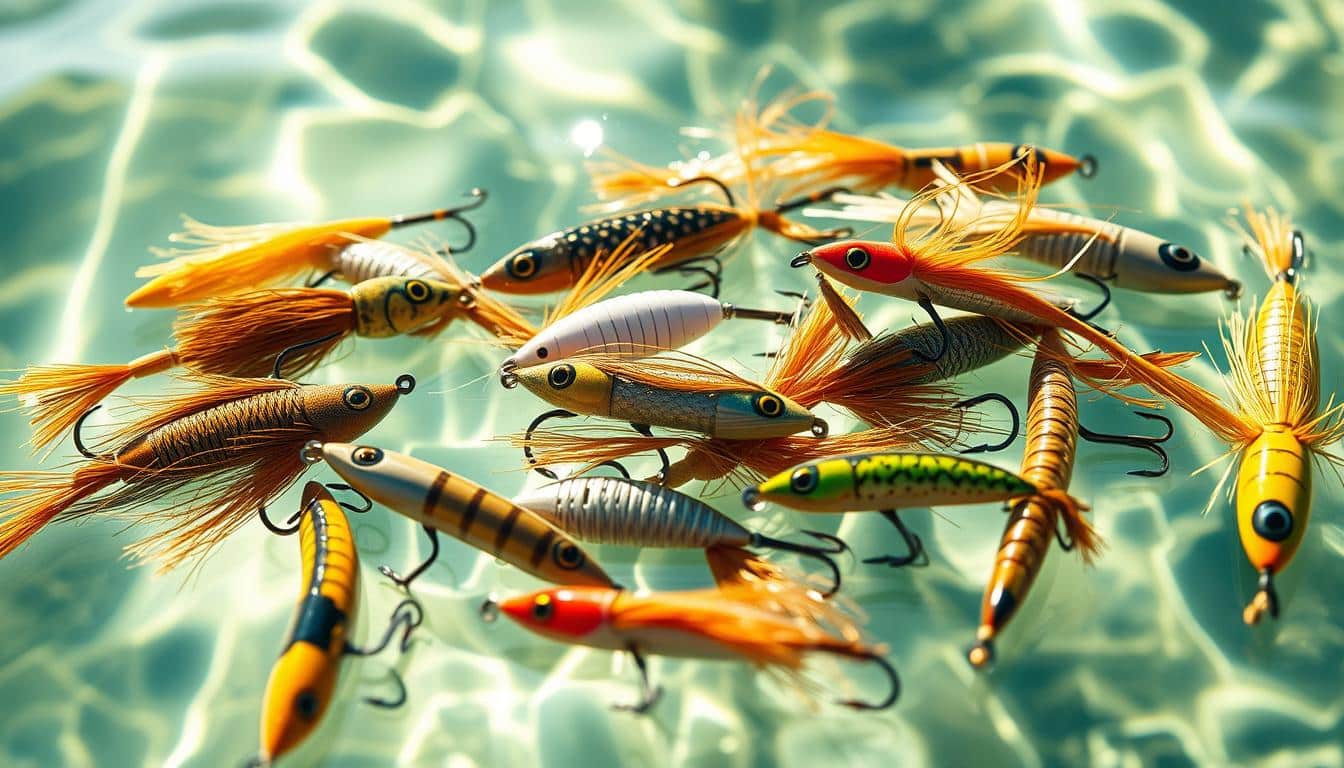Bass fishing is about mastering key presentations. These include soft-plastic worms, blade baits, topwaters, jigs, crankbaits, and swimbaits. These seven types cover most fishing situations when you match them to the environment and water temperature.
For better results, focus on a few reliable lures. Carry hardbaits like walking topwaters, poppers, and suspending jerkbaits. Include lipless crankbaits, swim and hair jigs, plus essentials like EWG hooks from Mustad, split rings, and bullet weights.
In early spring, timing and the right presentation matter a lot. When the water is around 50°F, choose slow suspending jerkbaits, finesse worms, and crawfish-colored jigs. Knowing how to read the water’s temperature and structure makes a difference, no matter the lure.
Switching to eco-friendly lures requires the same basics. Concentrate on the lure’s purpose, how you present it, and the right time to use it. Opting for plastic-free gear lets you fish with care. You don’t have to give up effective fishing strategies.
Why Choose Plastic-Free Bass Lures: environmental and performance benefits
Many fishers get overwhelmed by ads for single-use soft baits. By picking non-plastic options like hardbaits, wood, or hand-tied lures, you stick to what works best. This choice also decreases the dependence on single-use plastics, which often get lost and pollute our waters.
Environmental impact of soft plastics and microplastics in fisheries
Soft plastics break down into tiny pieces, leading to microplastic pollution in our water. These tiny pieces get into water systems, harming fish and other water life. By using less soft plastic, we help keep our waters cleaner.
Regulations, local bans, and growing consumer demand in the United States
Laws about fishing gear are getting a closer look by local and state officials. In places like Wisconsin, fishers are choosing more sustainable lures to reduce plastic waste. This change is part of why there’s a bigger demand for eco-friendly fishing gear.
Performance advantages and trade-offs compared to conventional plastics
Metal and wood lures offer unique benefits like better vibration and specific movement. While eco-friendly rubbers aim to replicate soft plastics, they’re not always the same. But choosing long-lasting lures means less waste and more time fishing without needing replacements.
How choosing plastic-free options supports conservation and long-term fishery health
Choosing repairable and durable lures helps reduce plastic pollution in our waters. This supports healthier fish populations and cleaner habitats. So, by opting for long-lasting materials, anglers help preserve our fisheries for the future.
Top plastic-free lure materials and what they imitate best
Anglers are choosing non-plastic materials aligned with bass diets and movements. This section highlights main choices, how they’re used, and the prey they resemble. Picking the correct material and retrieval technique makes the lure seem real and encourages strikes.
Wood lures: buoyancy, action, and classic profiles
Wood baits offer action above and below water that plastics can’t. Classic examples from Rapala and Live Target demonstrate. They show how wood creates water disturbances that mimic prey like baitfish or frogs.
To mimic erratic prey, use wooden topwater lures with specific movements. Pausing or twitching them can lead to aggressive strikes from bass near cover.
Metal and composite lures: vibration, flash, and durability
Metal baits like blade baits and spoons are great at creating vibrations. Lures from Bomber and Rattlin’ Rapala are designed to catch fish’s attention.
Lipless crankbaits and spoons shine and fall quickly, simulating shad or injured fish. Try different speeds and movements to mimic these scenarios.
Biodegradable rubber and plant-based polymers
Companies are now making soft lures from plants instead of PVC. Z-Man is a brand that proves these green alternatives can perform just as well for certain fishing techniques.
Remember to keep these baits cool and stored right, as heat can change their effectiveness. They’re great for subtle techniques like using worms that slowly sink.
Naturally sourced materials and hair/feather jigs
Hair jigs, made with materials like bucktail or marabou, mimic crawfish and leeches well. Boutique brands offer hand-tied jigs that work great with added natural bait.
Adding a natural trailer can slow the descent and add scent, improving catches near structures or during spawning seasons.
- Match wooden topwater lures to calm, shallow conditions and topwater feeding.
- Choose metal blade baids when bass are keen on vibration or in colder waters.
- Keep biodegradable soft baits cool and dry to maintain their effectiveness and lifespan.
- Use hair jigs with natural trailering for the most realistic crawfish and leech imitations.
Plastic-Free Bass Lures: Top Picks and Techniques
For bass fishing, pack some wooden topwaters, metal spoons, and biodegradable baits. Add a few reliable jigs too. Mixing up how you move and rig them makes these lures catch more fish.
Best wooden topwaters and working them
Vary how you move wooden topwaters for best results. Try River2Sea Rover 98 or Live Target Yearling Baitball for a smooth action. Use gentle twitches and pauses when light is low to get big strikes.
For pops, use Megabass Pop-X and Rapala Skitter Pop with strong pops and then wait. StrikePro Hunchback, a wakebait, needs constant motion to look like escaping prey.
Top metal options and retrieve styles
Blade baits and spoons are great for controlling depth and causing vibrations. Go for well-known lures like Rattlin’ Rapala and Bomber Ratl RRR A for instant hits.
- Quick moves and stops make blades attract attention.
- Smooth pulls with stops are best for spoons in murky waters.
- Lipless crankbaits need a steady speed and quick rod moves for suspended fish.
Biodegradable finesse options for Ned rigs, dropshots, and wacky rigs
Use small swimbaits and plant-based baits for lighter fishing styles. Z-Man TRDs and Hula Sticks are good, earth-friendly choices for Ned rigs and dropshots.
Try gentle lifts and pauses. Smaller lures work best for careful bass in busy waters.
Recommended jig heads, hair jigs, and natural trailers
Choose jig heads based on where you’re fishing. Arky and swim-jig heads are great for fishing near weeds and rocks.
- Kalin’s and bucktail jigs show realistic movements near places where crawfish hide.
- For deeper spots, go for VMC BKJ bucktail or Northland Deep-Vee.
- NedlockZ and Finesse BulletZ keep biodegradable baits fixed on jigs for sure catches.
Mix top wooden topwater brands with the best blade baits for a versatile collection. Include biodegradable lures and hair jigs to fish around structures and in the open water without traditional plastics.
Rigging and retrieves: techniques tailored for plastic-free lures
When you switch to lures made of wood, metal, hair, or biodegradable materials, you’ll need to tweak how you rig and retrieve them. These changes ensure your lure moves naturally and hits the strike zone often. Here are easy, effective tactics for fishing in rivers, lakes, and thick cover.

- Walk-the-dog cadence is perfect for buoyant wooden plugs from Rapala and River2Sea. Short rod twitches followed by a pause mimic hurt baitfish.
- Popping twitching gets fish to react. Snap the rod quickly, then reel fast twice so blade baits “jump” and draw attention.
- Pair braid with a 20-lb mono leader for better floatation and fewer twists. This works well with lightweight wooden topwaters.
Slow-rolling and the yo-yo retrieve for metal and lipless cranks
- With blades and spoons, slow-roll by structures to keep vibrations within the strike zone. A steady reel speed is key in all water types.
- For yo-yo retrieves with lipless crankbaits, let the bait sink, then lift and drop the rod. Strikes often happen on the drop, so stay alert during pauses.
- In cold water, increase pause times and make shorter lifts. This matches the slower movement of fish.
Pitching, flipping, and swim-jig retrieves with natural trailers
- Use soft, natural trailers and hair-jigs for precise casts into tight spots. An underhand throw minimizes splash, offering a believable presentation.
- Swim-jigs need a steady, medium-speed retrieve through weeds. This keeps the skirt and trailer moving like a real fish.
- For thick cover, choose weedless Texas-style rigs. Combine braid with a mono or fluorocarbon leader for feeling bites and resisting wear.
Finesse approaches using biodegradable soft baits
- The Ned rig excels with subtle hops and pauses. Use a light head, let the bait sink, then twitch it lightly to attract bass.
- Dropshot and wacky setups benefit from small twitches and long pauses in cold water. This boosts your chance of a bite.
- Secure biodegradable baits with NedlockZ or BulletZ-style hooks for reliable performance after many casts.
Practical rigging options summary
- Topwater retrieves: use braid with a mono leader; apply short twitches followed by pauses.
- Yo-yo retrieve lipless crankbait: lift, let fall, and be ready to strike on the drop.
- Pitching swim-jigs: aim precisely, maintain a consistent swimming speed through weeds.
- Ned rig biodegradable bait: focus on gentle hops and lengthy pauses, use light heads for a natural descent.
Matching lure choice to water, season, and bass behavior
Choosing the right plastic-free lure means looking at water temperature, clarity, and how bass eat. First, notice the water’s color, if there’s action on the surface, and where fish hang out. Match your lure’s action and shape to these factors to catch more fish.
Early in the year, bass are slow and like subtle lures. Move your lures slowly and pause often to make them seem alive. Try using a wooden jerkbait just under the surface, making long, slow movements.
Also, try small metal baits. Move them up and down slowly to grab the attention of lazy fish.
Near rocks and transitions, use hair jigs that look like crawfish. In clear lakes, like in Wisconsin, pick smaller lures and light lines. This helps when fish can see every detail.
During warm months, lures that make noise on the surface work best in weedy areas. Make a wakebait move in short, quick bursts near the edges of weeds to mimic escaping baitfish.
Swim jigs are great for thick cover. Choose soft, lifelike trailers and reel in smoothly to avoid weeds. In busy waters, use topwater lures that make bass bite out of surprise near windy shores.
In clear water, pick lures carefully. Favor subtle colors, smaller sizes, and gentle movements. Go for natural colors and soft vibrations so fish don’t get scared away.
- Use mono leaders for topwaters in clear water to keep baits up and hide the line.
- Pick fluorocarbon leaders for being sneaky and durable near rocks or wood.
In murky water, you need lures that stand out and make noise. Use metal blades or lipless crankbaits with big profiles. Choose bright or dark colors to be seen when water is very muddy.
Choosing the depth depends on your lure’s type and weight. Wooden lures float and need specific moves to attract fish. Metal baits sink quickly and work best with fast, up-and-down retrieves for deeper areas.
Check how fast wooden lures sink before using them. Their grain or added weight affects their drop speed. Test them before fishing to know their speed and how they move.
Biodegradable lures come in different weights. Match them with appropriate jigheads for the depth you’re fishing. Start light for shallow water and go heavier for deeper spots. Keep trying different moves until you find what works.
Tackle, line, and terminal gear recommendations for non-plastic lures
Picking the correct tackle ensures that lures made of wood, metal, and biodegradable materials fish well. It’s about matching your rod, reel, and line to each lure. This optimizes lure action and improves your chances of catching fish. Small tweaks to your hooks and terminal tackle can significantly impact success, especially when fishing in areas with lots of cover.
-
Rod and reel pairings by lure type
-
For topwater lures: use baitcasting combos that have medium-heavy rods. Choose reels with a 6.3:1 or 7.1:1 ratio for quick line retrieval and strong hooksets. Combine braid with a 20-lb mono or fluorocarbon leader to keep the line floating and prevent twist. This combo suits walk-the-dog and popper lures perfectly.
-
Jigs and hair rigs benefit from medium-heavy rods. Pair these with strong baitcasters or sleek reels. Look to brands like Penn and Shimano for tough reels. They’re great for handling braided lines and navigating through thick cover.
-
Metal and lipless lures work best with medium-action rods. These have fast tips and pair with 6.1:1 reels to adjust retrieve speed easily. Opt for heavier lines and think about using fluorocarbon leaders from Seaguar Red Label. This is essential for stealth and resistance against abrasion.
-
Finesse lures call for lighter spinning rods paired with 2000–3000 series reels. Fluorocarbon lines within 8–15 lb test are ideal. Gear ratios close to 6.2:1 provide a good mix of speed and control. These setups are excellent for using Ned rigs and dropshots.
-
-
Line choices and leader strategies
In thick cover, braid is tops for powerful hooksets but pair it with a leader for invisibility and better bait float. Choose mono or fluorocarbon leaders depending on how deep you’re fishing or if you’re targeting toothy fish. A common setup is 30–50 lb braid with a 10–20 lb fluorocarbon leader.
Fluorocarbon lines between 10–15 lb test are perfect for clear water and early spring. They sink faster than mono, which helps set the hook properly for hair jigs and lifelike soft baits.
-
Hook selection and weed-guard options
Pick hooks that match your lure’s size and the bait type. Brands like Trokar and Mustad make thin-wire weedless hooks. These are great for clear waters where every hit counts. For bigger, eco-friendly baits, EWG or offset hooks by VMC or Gamakatsu offer strong bends.
For weedless setups, opt for wide-gap wacky hooks with wire guards or Trokar Weedless Wacky Hooks. These are good for soft, plant-based baits. For hair jigs, choose hooks that have snug noses and sharp tips. This ensures they pierce through natural baits easily.
-
Terminal tackle to protect lures and prevent loss in heavy cover
Good terminal gear keeps your eco-friendly lures safe and decreases the chance of snagging. Opt for durable split rings, rust-proof swivels, and steel leaders when targeting fish with sharp teeth.
Use O-rings and NedlockZ retainers to hold biodegradable baits securely without harming them. Always carry extra split rings and a small crimper. This way, you can replace any worn parts quickly while fishing.
Keep your terminal tackle simple but effective. Quality hooks, split rings, and the right leaders can make or break your fishing success. They also help your biodegradable lures last longer. Match your gear to the lure type and fishing spot for the best results.
Maintenance, storage, and longevity of plastic-free lures
Looking after wooden, metal, and biodegradable lures keeps them ready for fishing and saves money. Simple habits after fishing avoid damage and waste. We’ll share tips for care at home and on the boat, plus gear for quick fixes.
Wood and composite care
After using, dry wooden and composite lures well to prevent them from swelling or the paint from lifting. For storage, use ventilated tackle boxes or racks that allow air flow.
If you find chips, seal them fast with CA glue or a thin lacquer layer. This keeps water out. Light sanding and touch-up paint will keep the lure’s shape and make sure it swims right.
Protecting metal components
After fishing, especially in dirty water, rinse metal parts and dry thoroughly. Put a little oil on parts like split rings to stop them from rusting.
To keep metal from rusting, have some corrosion inhibitor or light oil handy. It’s also good to sharpen hooks and make blades shiny for better lure action.
Storing biodegradable soft baits and natural trailers
Store biodegradable baits in a cool, dry place. Keep them away from regular plastics to prevent damage.
For these baits, use bags or containers that breathe but can be sealed, with something to absorb moisture. This way, they won’t mold or get too soft.
Practical in-field fixes
- Bring extra split rings and hooks to swap out damaged parts quickly.
- Have CA glue, a file, and spare o-rings ready for quick lure repairs, like fixing chips or replacing parts on wooden lures.
- Mark line adjustments or depth changes and check lure action after making fixes.
Routine checks and simple habits
Check your lures while fishing to fix small issues before they get worse. Trim skirts and refresh natural parts to keep lures looking real and cut down on replacements.
Having a small repair kit on your boat makes fixing lures easy. This helps your non-plastic lures last longer.
Where to buy and trusted brands making plastic-free bass lures
Start with what works instead of wanting everything new. Choose a few lures perfect for your area: think about getting a wooden topwater, a trusty popper, a lipless crank, some metal blades, and a couple of finesse pieces. This method keeps your tackle box ready and lets you try out biodegradable baits and handmade jigs without spending too much.

Both specialty and big brands are worth your time. Check out Rapala, Megabass, Live Target, and River2Sea for hardbaits that move just right. For handmade jigs, Kalin’s and Northland Tackle offer tough options good for thick places and they can be fixed. Try Z-Man and TT Lures for their plant-based and biodegradable soft bait brands.
Shop around different places. Local bait shops in the Midwest and Wisconsin are great for checking out wooden lures in person by looking at their finish and hook quality. Online stores like Tackle Warehouse, Bass Pro Shops, and Cabela’s have lots of choices and ship fast. Buying directly from wooden lure makers in the USA and smaller producers gets you unique finishes and handmade jigs that mimic local fish food.
Be smart when picking sustainable lures. Look at the product info for specifics like plant-based stuff or biodegradable rubber. Read reviews to learn if the lure works well over time, moves right, and lasts after lots of catches. Certifications or tests from outside the company make their biodegradable claims more believable.
- Check where and how items are made on the product page.
- Go for items with clear info on materials and tested quality.
- Choose brands that offer tips on caring for wooden and biodegradable baits.
Mix budget-friendly and high-end items for a plastic-free collection. Affordable choices from Rebel, Mann’s, and Bomber let you experiment. Spending more on Megabass, Live Target, and handcrafted wooden lures means better look, movement, and fixing options. For jigs, get a few premium handmade ones and have less costly versions for practicing in tough spots.
- Start: one wooden topwater and one popper for surface action.
- Add: a lipless crank and a couple of blades or spoons for different retrieves.
- Include: a swim jig plus two handmade jigs for flipping and pitching.
- Stock: a few biodegradable soft bait brands for finesse setups.
Choosing sustainable lures means going for versatility and tested designs. Pick actions that bass like. Quality is key, even before giving up all plastic. Grow your collection slowly, stick with durable handmade jigs and biodegradable options with good reviews, and turn to wooden lure makers in the USA for classic topwater gear.
Conclusion
Go back to the basics: Learn key lure types and rigs to catch more fish and use fewer soft plastics. Using Texas, Carolina, Ned, dropshot, and shaky head rigs with non-plastic baits can make your tacklebox work better without plastics. This helps you fish smarter with every trip.
Build a simple tacklebox that you trust, based on the area and season. Fill it with wooden topwaters, metal blades, hair jigs, and biodegradable baits. Keep a small kit of hooks, split rings, and leaders to quickly adjust. This keeps your lures in good shape for any situation.
Change how you fish based on water conditions and bass activity. Use slow moves in cold water and faster ones as it warms up. Fishing with care for the environment cuts down on water pollution. It also protects fish homes all around the country.
Choosing sustainable fishing practices improves your game and reduces harm to the environment. A tacklebox without plastics ensures good catches and shows respect for nature. This helps make sure future fishers will enjoy the sport as much as we do.
FAQ
What are the best plastic-free lure types for bass fishing?
How does choosing plastic-free lures help the environment?
Are there performance trade-offs when switching from PVC soft plastics to biodegradable or non-plastic lures?
Which plastic-free lures should I include in a compact, confidence-based “Base Box”?
How should I rig and retrieve plastic-free topwaters and metal baits?
What are the best early-spring presentations using plastic-free lures?
How do water clarity and temperature affect color and material choices?
What rod, reel, and line setups work best with plastic-free lures?
Which brands and models are trusted for plastic-free or durable lures?
How do I maintain and repair plastic-free lures to extend their life?
What field repairs and spare parts should I carry to avoid losing plastic-free lures?
Are there regulatory or consumer-trend considerations when choosing biodegradable or plastic-free lures?
Can biodegradable soft baits fully replace traditional PVC plastics for finesse techniques?
How should I choose lure colors and sizes when switching to plastic-free options?
What terminal tackle is essential to protect plastic-free lures in heavy cover?
How do I transition my fishing to a plastic-free approach without sacrificing catch rates?
Content created with the help of Artificial Intelligence.



